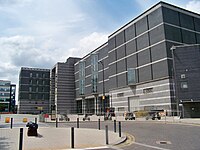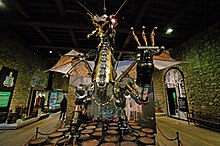Royal Armories
 Royal Armories Museum, Leeds |
|
| Data | |
|---|---|
| place |
Leeds (Royal Armories Museum) London ( White Tower ) Portsmouth ( Fort Nelson ) |
| Art |
historical Museum
|
| architect | Derek Walker |
| opening | 1983 |
| Number of visitors (annually) | ~ 2 million |
| management |
Edward Impey (Director General of the Royal Armories and Master of the Armories)
|
| Website | |
Royal Armories is the UK's national arms and armor museum. The museum goes back to the arms workshop of the English kings in the Tower of London . Established in the 15th century, it is the oldest museum in the UK and one of the oldest in the world. Today most of the collection is on display in a museum in Leeds , while smaller parts of the collection are still in the White Tower of the Tower of London, Fort Nelson in Portsmouth and the Frazier History Museum in Louisville, Kentucky, USA
collection
Royal Armories has one of the largest collections of weapons and armor in the world. In addition to these collections, Royal Armories also keeps the archives of the Tower of London and sees itself as the guardian of its history.
staff
The museum has been a legally independent foundation since the National Heritage Act of 1983. Originally it was part of the British Defense Department and later the Environment Department.
The museum staff is often busy decorating and advising historical television series and films. So far, this includes, for example, Heinrich V from 1944 as well as Henry V from 1989, Hamlet from 1990, Robin Hood from 2010, Braveheart , Rob Roy or the Kingdom of Heaven .
history
Spanish Armory and Line of Kings
The tower was an early object of interest due to its imposing shape, the tower menagerie and its rich history, and people began to visit it. The extensive arsenals maintained by the Board of Ordnance soon aroused interest. The earliest records of visitors who were able to view the Tower's collections for an entrance fee exist from Paul Hentzner and from Basel Joseph Platter in 1599, who paid 21 shillings for his visit to the collections in the White Tower.
Prepare the idea that weapons and other military Ausrüstungegenstände for visitors and targeted issue, probably dates back to the reign of Charles II. Originally The Spanish Armory named Museum presented the Tower of London, especially relics of victory over the Spanish Armada out showed but also from the very beginning historical pieces such as armor and weapons from Henry VIII or clubs, with which Saxon English women are said to have defended themselves against attacking Danes in the 9th century.
The Line of Kings was created at the same time as the Spanish Armory . Here stood life-size figures of former British kings on horses, equipped with weapons and armor of their time. The authenticity of the weapons and armor was very different depending on the king.
In the 17th century, the exhibit was in one of the warehouses north of the White Tower. When these were demolished in the 1680s for the construction of the Grand Storehouse , the Spanish Armory moved into a newly built building in the innermost fortress ring. This stood in the wall north of the Wakefield Tower and is no longer there today. After several years of temporary storage, the collection moved to the New Armories at the beginning of the 18th century .
Small Armories and Artillery Room
A third collection, the Small Armory, was created after the Grand Storehouse was built on the upper floor. There were mainly 60,000 modern hand weapons, which were arranged together with carved wooden frames in often larger than life spectacular structures and figures. The Small Armories contained dragons, snakes, suns, chariots, waves, whale bones or the "Witch of Endor."
While the Small Armories was designed for visitors from the start, the Artillery Room only slowly developed into it. This was on the ground floor of the Grand Storehouse, where the artillery of the Tower and the Board of Ordnance was stored. In addition to their own weapons, the Army also used the building to store special weapons or loot, which in turn quickly attracted visitors.
Both Small Armories and Artillery Room were lost in the fire of the Grand Storehouse in 1841. There are numerous written descriptions of both of them, but no photo evidence.
Queen Elizabeth's Armory
Under the Duke of Wellington , who served as constable of the Tower in the first half of the 19th century , the exhibition was renamed Elizabeth's Armory in 1831 . The Duke was taking into account the fact that most of the exhibits no longer came from the Spanish Armada. The new name goes back to Elizabeth I, who founded the collection.
At the time, the exhibition was in a room in the White Tower . Above all, it showed a wide variety of weapons from all ages. And although it also showed weapons of dubious authenticity (e.g. the ax with which Anne Boleyn 's head was cut off, or the weapons of legendary English kings), the catalog already noted that the anecdotes and stories were often not very credible.
Various torture instruments were also found in the exhibition room. Both weapons and instruments of torture were freely accessible; visitors were allowed to touch, pick up and carefully try them out.
At the end of the room was a figure of Queen Elizabeth I. Similar to the kings in the Line of Kings , she was sitting on a horse. She was assisted by a page. Elizabeth wore the same dress she wore when she thanked God at St Paul's Cathedral for repelling the Spanish Armada.
The room in which Queen Elizabeth's Armory was located also served as a prison cell at times. Various prisoners left inscriptions and pictures on the walls, which complemented the exhibition of weapons and torture instruments. From the room the door opened to a much smaller windowless room. According to tradition, this was said to have been Walter Raleigh's cell .
Since 1996
The collection first moved out of the Tower of London in 1996. In the course of the decentralization of the United Kingdom, large museums were to leave London for the first time in the 1990s and move to other areas of the country. A special museum building was built for the Royal Armories in Leeds in Yorkshire in the north of England.
The museum held a special exhibition in Leeds in 2008 when it first turned to weapons that had been made for the cinema. The centerpiece of the exhibition were 120 weapons and armaments that Weta Workshop had made for the Lord of the Rings trilogy. This exhibition was visited by a total of 160,000 people,
building
Originally, Royal Armories was located in the Tower of London. Only at the end of the 20th century did the museum begin to erect additional buildings to show exhibits that could no longer be accommodated in the tower itself.
Most of the collection is now on display in Leeds. After the rooms in the tower had been too small for centuries and almost the entire collection was in the arsenal, the museum created new rooms in 1996 to be able to exhibit at least a larger part of the collection. Erected in 1996 in Leeds based on plans by Derek Walker , the building is the first to open as the home of a national museum outside of London . It thus followed the political program of devolution in the United Kingdom, which was to break up the central role of London. The £ 42.5 million building, built as a public-private partnership , was to be built in Sheffield or Leeds in Yorkshire , but no agreement could be reached with the city fathers. In the year it opened, 360,000 visitors came to the museum, making it one of the top 20 most visited museums in the country.
Publications
In addition to various books, the Royal Armories has been publishing the scientific journal Arms & Armor since 2004 as the successor to the Royal Armories Yearbook .
literature
- Charles John ffoulkes : Inventory and survey of the armories of the Tower of London , London 1916 at archive.org
Web links
- Museum website
Remarks
- ^ Director General and Master of the Armories
- ↑ a b Raphael Samuelson: Island Stories: Unraveling Britain Verso, 1998 ISBN 1-85984-965-2 , p. 102
- ^ Robert C. Woosnam-Savage: The Material of Middle-Earth. Arms and Armor in Peter Jackson's The Lord of the Rings Motion Picture Trilogy in: Janice M. Bogstad, Philip E. Kaveny (Eds.): Picturing Tolkien: Essays on Peter Jackson's The Lord of the Rings Film Trilogy p. 143
- ↑ a b c d Geoffrey Parnell: The Tower of London: Past and Present The History Press 2009 ISBN 978-0-7524-5036-0 , p. 57
- ^ Edward Impey and Geoffrey Parnell: The Tower of London. The official illustrated history, London: Merrell 2000, 128 pp., ISBN 1-85894-106-7 , p. 70
- ^ A b Geoffrey Parnell: The Tower of London: Past and Present The History Press 2009 ISBN 978-0-7524-5036-0 , p. 58
- ^ Hodgson: A Short History of the Tower of London, including a Particular Detail of its Interesting Curiosities; with a Brief Account of many of the most celebrated Kings of England, Noblemen, and others, whose Figures in Armor, and sitting on Horseback, are exhibited in the Horse Armory. J. Macrone: The London and Westminster review, Volume 31, 1838, pp. 28ff.
- ^ Robert C. Woosnam-Savage: The Materiel of Middle-Earth. Arms and Armor in Peter Jackson's The Lord of the Rings Motion Picture Trilogy in: Janice M. Bogstad, Philip E. Kaveny (eds.): Picturing Tolkien: Essays on Peter Jackson's The Lord of the Rings Film Trilogy p. 142
- ^ Corporate City: The Role of Consumer Services in the Rejuvenaton of Leeds in: Colin C. Williams (Ed.): Consumer Services and Economic Development Routledge, 1997 ISBN 0-415-14504-X , p. 193
- ↑ https://royalarmouries.org/what-we-do/publishing
- ↑ https://royalarmouries.org/what-we-do/publishing/ra-journal ( page no longer available , search in web archives ) Info: The link was automatically marked as defective. Please check the link according to the instructions and then remove this notice.



